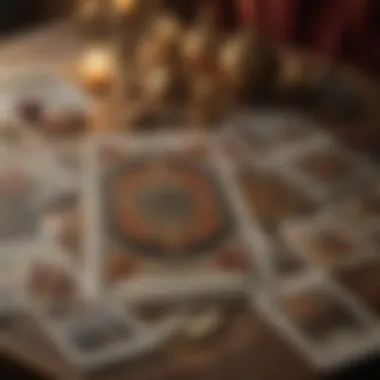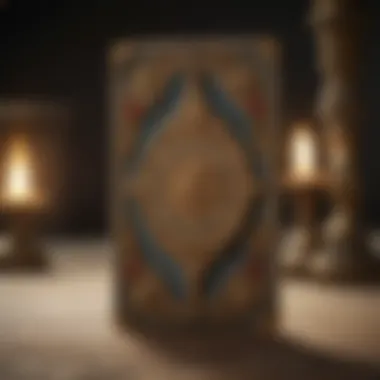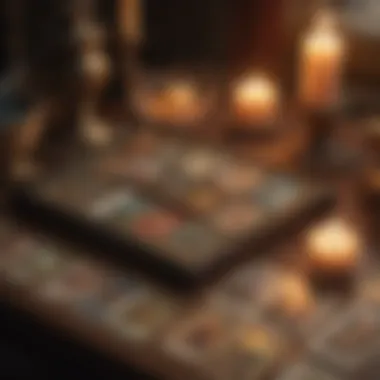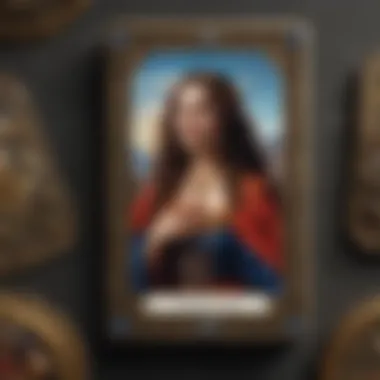Tarot Cards: Meanings and Insights for Self-Discovery


Intro
Tarot cards have fascinated individuals for centuries. They are often seen as tools for divination, offering insights into one’s life and potential future. However, they are not merely about predicting outcomes. They carry rich symbology and meaning that can lead to profound personal introspection.
In this guide, we will explore the meanings of tarot cards, touching on their historical context and contemporary application. By understanding each card’s symbolism, users can utilize the tarot as an instrument for self-discovery and guidance. This guide aims to benefit both newcomers and experienced tarot practitioners.
This discussion will unfold into various sections, each offering a different facet of understanding—the major and minor arcana, interpreting techniques, and practical tips for effective reading. The objective here is to furnish you with a deep comprehension of tarot, paving the way for a reflective journey through its use in navigating life’s complexities.
Intro to Tarot Cards
Understanding tarot cards is crucial for anyone interested in their meanings, history, and applications. This introduction provides the foundational knowledge necessary to appreciate the intricate details that follow in the article. Tarot cards are often seen as a bridge between the tangible and the mystical, allowing users to explore their subconscious and harness intuition. Each card possesses a wealth of symbols and meanings that can lead to deeper insights when interpreted correctly.
The study of tarot goes beyond mere fortune-telling; it encompasses psychological introspection and personal growth. A cautious approach to interpretation is essential, as different spreads, contexts, and individual perceptions can significantly alter the meaning of each card. This article aims to demystify tarot while also acknowledging its complexity, fostering a nuanced understanding for both beginners and experienced practitioners alike.
Definition of Tarot Cards
Tarot cards comprise a set of 78 cards, commonly divided into two main sections: the Major Arcana and Minor Arcana. The Major Arcana consists of 22 significant cards that symbolize pivotal life events and spiritual lessons. The Minor Arcana, on the other hand, consists of 56 cards divided into four suits, which reflect everyday experiences and challenges.
Tarot cards are not just tools for divination; they serve as a mirror, reflecting one's inner thoughts and emotions. It is this dual role that makes them both fascinating and valuable for self-exploration.
Historical Context of Tarot
The history of tarot cards is rich and varied, with roots that trace back centuries. Understanding their historical context adds depth to their meanings and uses today.
Origins in Europe
Tarot cards originated in Europe during the 15th century, primarily associated with card games. The earliest decks were not created for divinatory purposes but rather as a form of entertainment among the elite. This historical context shows that tarot has always been intertwined with culture and society. The intricate artwork of these early cards holds a unique charm that appeals to many. The transition from a mere card game to a tool for spiritual guidance marked a significant shift in the perception of tarot.
Evolution over the centuries
Over the centuries, tarot has undergone a significant evolution, reflecting broader societal changes. By the 18th century, tarot began to gain popularity as a mystical tool, influenced by spiritual movements and philosophies. This evolution is notable because it highlights how cards have adapted and gained diverse meanings, resonating with different belief systems. As new decks were created, they incorporated symbolism and imagery from various cultures, enriching their interpretations. This adaptability has made tarot an enduring subject of study and fascination.
Tarot's association with mysticism
The association of tarot with mysticism has fostered numerous beliefs and practices surrounding its use. This relationship gained traction particularly during the 20th century, as people sought deeper spiritual connections. The unique feature of tarot's connection with the mystical realm offers users a sense of exploration beyond the physical world. However, this association has also led to misconceptions, often labeling tarot as purely a tool for fortune-telling rather than self-exploration. Understanding this aspect is vital for anyone looking to engage with tarot meaningfully.
Tarot serves as a way to unlock the deeper layers of our consciousness, rather than merely predicting the future.
Understanding the Structure of Tarot Decks
Tarot decks are the foundation of tarot reading. Understanding their structure helps users navigate the symbols and meanings that each card holds. Each deck typically consists of 78 cards, divided into two main categories: Major Arcana and Minor Arcana. Each card carries its own significance, making it crucial to understand how these components interact within a reading. A thorough grasp of tarot decks allows for deeper insights during interpretations, facilitating greater self-discovery and exploration.
Types of Tarot Decks
Tarot decks vary significantly, each designed with different themes and symbols. This variation enriches the reading experience, allowing readers to choose decks that resonate with them personally.
Traditional Tarot Decks
Traditional tarot decks, such as the Rider-Waite-Smith, have a rich history and maintain conventional imagery and symbolism. They usually feature recognizable iconography, which serves as a reliable reference for interpretation. The common use of well-established symbols enhances their appeal for beginners and seasoned readers alike.
One key feature of traditional tarot decks is the consistency in card meanings across different readers. This uniformity makes them a beneficial choice for those just starting their journey in tarot.
However, the drawback is that they may feel outdated for some users who look for modern interpretations or new perspectives.
Modern Interpretations


Modern interpretations of tarot decks can offer fresh insights or create personalized versions that reflect contemporary themes. These decks often include unique artwork or updated symbols, making them appealing to a wide audience. The distinctive characteristic of these decks is their creativity and departure from traditional aesthetics.
Modern tarot decks typically aim to capture diverse perspectives and experiences, thus attracting a younger demographic who feels less connected to conventional decks.
Nevertheless, this diversity can confuse users who are accustomed to the standard meanings associated with traditional decks.
Specialty Decks
Specialty decks are designed for specific purposes, such as thematic readings or self-exploration. Examples include oracle decks or decks focused on personal growth rituals. They focus on particular aspects of tarot and can serve as supplementary tools to more traditional tarot readings.
Unique features of specialty decks include specialized imagery or unique card layouts that may not align with traditional structures. This specialization can be beneficial for readers seeking focused insights, but it might disadvantage those wishing to draw from a more comprehensive perspective gathered from classic decks.
Major Arcana vs. Minor Arcana
Understanding the difference between Major and Minor Arcana enhances the overall comprehension of a tarot deck. Major Arcana cards symbolize significant life events, spiritual lessons, and profound themes. In contrast, Minor Arcana cards delve into the day-to-day experiences of life, providing detailed insights into specific situations.
Significance of Major Arcana
Major Arcana cards represent pivotal moments in a person's journey. Each card encapsulates a deep archetype, highlighting overarching themes and milestones. The resonance of these cards in readings usually points to substantial shifts and events that may require reflection.
The pivotal feature of Major Arcana cards is their ability to convey deep, transformative messages, making them a vital component in any tarot reading. However, their complexity can sometimes lead to overwhelming interpretations if the reader is not familiar with their significance.
Overview of Minor Arcana types
Minor Arcana is categorized into four suits: Cups, Swords, Wands, and Pentacles. Each suit deals with different aspects of life, such as emotions, intellect, ambition, and material concerns. The structured categorization allows readers to dissect situations based on their elemental associations.
The key characteristic of the Minor Arcana is its ability to offer detailed insights into everyday experiences. However, the vast variety of cards can lead to misinterpretation without adequate context.
Connecting Major and Minor Arcana
The relationship between the Major and Minor Arcana provides a holistic view of a reading. Major Arcana cards set the stage for significant journeys, while Minor Arcana cards fill in the fine details of daily life experiences. Understanding this connection helps readers craft more nuanced interpretations, weaving together themes of larger significance with the complexities of day-to-day living.
The unique feature of this connection lies in its potential to guide users towards comprehensive self-reflection. However, misalignments in interpretations of both arcana can dilute the clarity of a reading.
Symbols and Meanings in Tarot
The examination of symbols and meanings within tarot is vital. Each symbol captured in the tarot cards carries a depth of significance. Understanding these symbols allows readers not only to connect with their intuition but also to interpret the cards with greater accuracy. Symbols do not merely represent; they hold space for insights and reflections. By contemplating these symbols, practitioners can gain clarity in navigating personal challenges and aspirations.
Detailed Exposition of Major Arcana Cards
The Major Arcana consists of 22 cards, each representing significant life themes and karmic lessons. These cards encompass universal experiences. Analyzing them can unpack profound wisdom regarding one's spiritual journey. Each card has a unique story and an array of meanings to consider. For instance, The Fool represents new beginnings but also the potential for naivety. This contrast offers a robust framework for interpretation.
Exploring Minor Arcana Suits
The Minor Arcana is divided into four suits: Cups, Swords, Wands, and Pentacles. Each suit reflects a specific aspect of human experience and emotion. Exploring these suits deepens the understanding of everyday events and challenges, providing practical insights into life's complexities.
Cups
Cups are fundamentally related to emotions, relationships, and spiritual connections. This suit is often seen as a reflection of one's inner world. The cards in this suit encourage exploration of feelings. Those seeking self-discovery find the Cups a crucial element in readings. Each card tackles a different emotional landscape. However, reliance on Cups too heavily may lead to neglect of practical matters.
Swords
Swords embody the realm of thoughts, decisions, and challenges. The imagery often portrays conflict and the need for rationality. Each card reveals insights or conflicts about truth and clarity. Practitioners often appreciate Swords for encouraging decisive action. However, they can also signify doubts and fears when encountered. A balance of Swords with other suits is usually indicative of a well-rounded interpretation.
Wands
Wands represent creativity, inspiration, and action. This suit encourages exploration of ambitions and passions. Wands often signify growth and new opportunities. Their presence in a reading invites the querent to embrace their potential. However, Wands can sometimes represent impulsiveness. Practitioners should be careful to discern when enthusiasm may overshadow practicality.
Pentacles
Pentacles concern material aspects, security, and physical realities. This suit anchors the reading in the tangible world. Each card emphasizes different aspects of financial or material resources. Pentacles encourage a pragmatic approach to life's challenges. They can serve as reminders of the importance of grounding oneself. Neglecting Pentacles may lead to unrealistic perspectives.


"Understanding the meanings behind each suit allows practitioners to navigate complex emotional landscapes with clarity."
Recognizing the interconnectedness of the suits enriches the interpretive process. A comprehensive understanding of symbols and meanings in tarot empowers individuals on their journey of self-discovery. The exploration of these components represents not just a learning curve, but an opportunity for growth.
Interpreting Tarot Cards
Interpreting tarot cards is a fundamental aspect of tarot reading. It involves understanding the messages conveyed by the cards and applying them to various contexts. This process invites self-reflection and can lead to personal insights. Each card carries specific meanings, but how these are interpreted can significantly change based on the reader's insights and the surrounding cards. Understanding interpretation allows for practical application during readings, making it essential for both novices and experienced practitioners.
Basic Principles of Interpretation
Understanding upright versus reversed meanings
The concept of upright and reversed meanings in tarot is pivotal. When a card is drawn upright, it usually signifies positive aspects or direct meanings tied to its symbolism. In contrast, reversed cards often indicate obstacles or hidden elements. This dichotomy enriches the interpretative process, offering a fuller understanding of each card's implications. Their benefit lies in the added depth they provide, allowing readers to approach readings with nuance and complexity. However, some may find this duality overwhelming or complex, which could lead to misinterpretations.
Contextual interpretation
Contextual interpretation is another critical element in reading tarot cards. This approach considers the specific situation, question, or energy of the reading. It emphasizes how external factors influence the meanings of the cards. The key characteristic here is adaptability; readings can shift based on themes and issues present during the session. This feature allows for more personalized insights but requires a skillful reader to connect all components accurately. Misalignment between the context and card meanings may dilute their impact.
Intuition in reading
Intuition plays a significant role in interpreting tarot cards. This intrinsic sense helps readers tap into a deeper understanding that goes beyond traditional meanings. The essence of using intuition in tarot reading is to foster a meaningful connection with the cards. Many readers regard this as a beneficial aspect of their practice because it often leads to significant moments of clarity and revelation. However, relying solely on intuition can lead to subjective interpretations, which might not align with a card's traditional meanings. Striking a balance between intuition and learned knowledge is crucial.
Common Card Spreads
Different card spreads serve various purposes and help in structuring readings. Each spread allows for unique interpretations based on the positions of cards and their relationships.
Celtic Cross
The Celtic Cross is a well-known card spread that offers comprehensive insights. Its layout involves ten cards, each representing different aspects of a question or situation. The key characteristic of the Celtic Cross is its depth; it covers various angles, from past influences to future possibilities. Many readers find it to be a beneficial choice for in-depth exploration of complex issues. However, its complexity may intimidate beginners, requiring practice to master.
Three-Card Spread
The Three-Card Spread is a simpler alternative that yields clear insights quickly. This spread traditionally represents the past, present, and future. The advantage of this spread is its ease of use, making it an ideal choice for novice readers or quick guidance sessions. The simplicity, however, may not provide enough depth for more complicated questions or situations.
Single Card Draw
The Single Card Draw is the most straightforward method for pulling insights from tarot. This technique involves drawing one card to focus on a particular question or theme. Its key characteristic is its immediacy; readers can quickly receive guidance or affirmation. This method is often employed for daily readings or to gain quick insights. However, it may offer limited depth or context compared to more elaborate spreads, which can be a disadvantage in certain situations.
"The beauty of tarot reading lies not just in the cards themselves, but in the interpretation and insight drawn from them."
In summary, the act of interpreting tarot cards demands attention to both their individual meanings and the broader context of the reading. Each principle discussed offers pathways for readers to connect with the cards and derive meaningful insights, ultimately enhancing their approach to tarot.
Practical Applications of Tarot
The practical applications of tarot card reading extend far beyond mere divination or entertainment. This section explores how tarot can serve as a pathway to self-discovery and personal growth. Through the lens of tarot, individuals can gain insights into their lives, understand complex emotions, and navigate life decisions with a greater sense of clarity.
Using Tarot for Self-Reflection
Tarot can be a valuable tool for self-reflection. Each card presents themes and symbols that resonate with human experiences. By engaging with these cards, users can explore their thoughts and feelings. This process encourages introspection and self-awareness.
A key characteristic of this practice is its flexibility. There are no strict rules governing how one should interpret the cards. Each reading can be unique to the individual, allowing for personal insights that may otherwise be overlooked. This adaptability makes tarot a beneficial choice for personal development. However, it does require an open mind and an eagerness to confront, and sometimes challenge, one's assumptions.


Incorporating Tarot into Daily Life
Set intentions
Setting intentions using tarot creates a focused mindset for the day. This process involves drawing a card each morning with the intent of discovering what to focus on. This practice anchors the individual in their daily purpose. The simplicity of this method makes it appealing for many. It enables users to align their actions with their values or long-term goals without overwhelming complexity. However, one drawback might be the risk of overthinking the drawn card's meaning.
Daily draws and journaling
The practice of daily draws coupled with journaling enhances self-awareness. When individuals draw a card and reflect on it in writing, it creates a documented journey. This compiles one’s thoughts, struggles, and insights over time. A significant characteristic of this method is its accessibility; anyone can do it with minimal equipment needed. Individuals find mutual benefit in recording feelings of uncertainty or joy. An observed limitation may be difficulty in maintaining consistency due to busy schedules.
Group readings
Group readings facilitate shared experiences among participants. In a setting where multiple people engage with tarot, discussions can lead to deeper insights. This collective perspective enriches the understanding of the cards' meanings. Group readings are a popular choice for community building and social interaction. They often foster strong connections and a sense of belonging. However, this method may not suit everyone, especially if individuals prefer solitary reflection.
"Tarot serves as both a mirror and a map, reflecting inner thoughts while charting pathways forward."
Thus, the practical applications of tarot cards are diverse. They encompass individual journeys of self-exploration and communal experiences that enrich understanding. Through various methods such as self-reflection, intention setting, and journaling, tarot becomes a versatile tool for personal growth.
Understanding Common Misconceptions
The topic of misconceptions surrounding tarot cards is essential within this article because it shapes how both novices and seasoned practitioners perceive this practice. Understanding these myths helps to create a more informed view of tarot, clarifying its purpose and potential uses. This section aims to dissect the prevalent misunderstandings by presenting factual information and thoughtful insights.
Debunking Myths about Tarot
Tarot and fortune-telling
Many people link tarot with fortune-telling, seeing it solely as a way to predict the future. While this aspect exists, it is only one side of the practice. Tarot can be a tool for exploration of one's inner self. It presents an avenue for insight into personal situations, emotional states, and decision-making processes. This belief that tarot is only for predicting future events can limit its potential.
- Key characteristic: Tarot's interpretative flexibility.
- Benefit of choosing this perspective: It encourages deeper self-reflection rather than merely seeking future predictions.
- Unique feature: Tarot highlights personal agency; the cards reflect situations but do not dictate outcomes. Understanding this can promote a more balanced view of tarot's role in a person's life.
Tarot as a tool of divination
Another common misconception is about viewing tarot as merely a tool for divination. While tarot readings can provide guidance, they are not definitive answers to life's problems. Many practitioners argue that tarot serves more as a mirror, reflecting the reader's thoughts and emotions back at them. This deep connection between the reader and the cards allows for better personal insight.
- Key characteristic: The reflective nature of tarot readings.
- Value for this article: It positions tarot as a powerful catalyst for personal growth.
- Unique feature: The ability of tarot to help users navigate their thoughts. It is not about external foresight, but rather about understanding internal landscapes.
Setbacks in tarot's acceptance
Tarot has faced various setbacks regarding public acceptance. Some view it skeptically, dismissing it as superstition. This skepticism can hinder individuals from exploring a potentially valuable tool for self-discovery. Acknowledging these barriers is vital for promoting understanding of tarot's benefits.
- Key characteristic: The lingering stigma associated with tarot readings.
- Importance: Awareness of these setbacks helps to foster a non-judgmental view of tarot, encouraging exploration rather than dismissal.
- Unique feature: Discussions surrounding tarot can create a more open dialogue about its potential for positive personal transformation. Recognizing the setbacks allows for a more balanced narrative about tarot's role in society.
In summary, twelve misconceptions commonly surround tarot cards; understanding and addressing these myths can encourage a clearer view of what tarot truly represents and how it can serve individuals on their personal journeys.
Closure
Understanding the nuances of tarot cards and their meanings is a valuable endeavor that extends beyond mere curiosity. This article has illuminated several facets of tarot, encompassing its historical fabric, intricate structure, and potential applications in modern introspection. The persistence of interest in tarot speaks volumes about its role as a tool for clarity in an often convoluted world.
The Enduring Appeal of Tarot
Tarot cards have captivated minds for centuries, and their allure is tied to a multitude of factors. One of the primary reasons for their enduring appeal lies in their rich symbolism. Each card not only carries a unique meaning but also resonates with universal experiences, making them relatable to a diverse audience. Many find comfort in the archetypal imagery presented in the cards, which speaks to the human experience of love, conflict, and growth.
Moreover, tarot serves as a conduit for self-reflection and personal growth. Engaging with the cards often encourages a dialogue between our conscious and subconscious minds, revealing hidden truths and guiding us through life’s challenges. The act of reading tarot can foster a heightened sense of awareness, unlocking insights that are often overlooked in our daily routines.
Additionally, the community surrounding tarot is vibrant and inclusive. Many practitioners connect with others through online platforms like Reddit or Facebook to share experiences and interpretations, further enriching their understanding. The collective sharing of wisdom enhances the practice and ensures its relevance in contemporary society.
"Tarot is not just about the cards; it is about the dialogue we have with ourselves through them."
This expression beautifully captures the essence of tarot. The process is inherently personal and versatile, allowing each user to tailor their experience. As readers apply the knowledge gained from this article, they will see that tarot can adapt to reflect their individual life circumstances.







